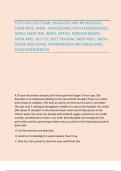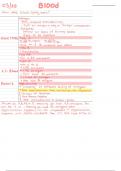TEST FOR CHEST PAIN, HEADACHE AND NEUROLOGIC,
SAEM PEDS, SAEM - PROCEDURES, PSYCH EMERGENCIES,
DERM, SAEM TOX, INFXN, OPTHO, FOREIGN BODIES,
SAEM AMS, 2017 CV, 2017 TRAUMA, SAEM MISC, SAEM -
SHOCK AND SEPSIS, ENVIRONMENT AND ENDOCRINE,
PULM EMERGENCIES
A 70 year old woman presents with chest pain that began 2 hours ago. She
describes it as substernal radiating to her jaw and left shoulder; there is no other
area of pain or radiation. She took an aspirin at home but the pain is not better.
She also took 3 sublingual nitroglycerin tablets en route to the hospital. Her initial
EKG shows ST elevation in the anterior leads >2mm and ST depression in the
inferior leads. The nurse has already administered oxygen, placed her on an EKG
monitor, and attained IV access. You order beta-blockade and nitroglycerin for
pain relief, and the supervising resident asks you which of the following should be
done next:
A. Call her primary care physician.
B. Send her to radiology for a good-quality chest X-ray.
C. Give her a GI cocktail to check for pain relief from this.
,D. Call cardiology for a decision between thrombolytic and percutaneous coronary
intervention.
E. Call cardiology The answer is D. This patient is having an acute myocardial
infarction. AMI is defined when two of the following three findings are present:
clinical history of chest pain of at least 20 minutes duration, EKG changes and/or
positive myocardial enzyme testing. This patient has ST elevation with
concomitant ST depression in contiguous leads with chest pain. She needs
immediate thrombolytic therapy or cardiac catheterization; if percutaneous
coronary intervention (PCI) can be achieved within 90-120 minutes of emergency
department arrival, the literature supports its selection over thrombolytic therapy
as primary intervention. In preparation for either thrombolytic therapy or PCI, you
need to control her pain, maximize O2 delivery, decrease work of the heart and
inhibit platelet function. O2, nitroglycerin and morphine will increase O2 delivery
to the heart. A beta blocker, which should also be administered to AMI patients
who lack contraindications, will decrease the work of the heart, and aspirin will
inhibit platelets. A glycoprotein IIb/IIIa-inhibitor should also be administered -
selections will depend on the exact treatment course chosen for the patient.
Anticoagulation with low molecular weight heparin or unfractionated heparin
(dose being dependent on exact treatment course for patient) should be started if
there are no patient historical or chest X-ray findings suggestive of aortic
dissection.
A 72-year-old male presents with five hours of substernal chest pain and pressure
despite taking three sublingual nitroglycerin. You order an EKG. What findings on
the EKG would indicate that this patient is potentially a candidate for thrombolytic
therapy?
A. Ventricular tachycardia
B. ST-segment elevation of at least 1 mm in two or more contiguous leads
C. ST-segment depression of at least 2mm in any precordial lead
D. Atrial fibrillation with a rapid ventricular response The answer is B.
"Fibrinolytic therapy is indicated for patients with STEMI (as a reperfusion option)
,if time to treatment is <6 to 12 hours from symptom onset, and the ECG has at
least 1-mm ST-segment elevation in two or more contiguous leads."
A 58-year-old male previously in good health presents with chest pain for two
hours. Vital signs are BP 126/78, HR 80 (sinus rhythm), RR 14, oxygen saturation
99%, T 36.8. His EKG shows ST segment elevation in leads II, III, aVF and V1. ST-
segment elevation is greater in lead III than in lead II. What additional diagnostic
test is indicated prior to giving nitroglycerin?
A. d-dimer
B. Echocardiogram
C. EKG with right-sided leads
D. CXR The answer is C. "Nitrate-induced hypotension is also suggestive of
right ventricular infarction, and of tamponade. Initial therapy for both would
include volume loading and avoidance of vasodilators or other agents that may
lower the blood pressure."
"ST segment elevation in lead V1 in the setting of inferior MI (i.e., ST segment
elevation in leads II, III, and aVF rather than in the setting of concomitant ST
segment elevation in all anterior precordial leads) is suggestive of right ventricular
infarction."
"ST segment elevation is usually greater in lead III than in lead II when right
ventricular infarction coexists with inferior AMI."
"Application of "right-sided" precordial leads is the best means to diagnose right
ventricular infarction with the ECG. These leads, as a mirror image of the left
precordial leads, demonstrate ST segment elevation with right ventricular
infarction in leads V3R to V6R, with V4R having the highest sensitivity."
A patient with nontraumatic chest pain is administered nitroglycerin in the field
and has subsequent drop in blood pressure. An EKG reveals ST-segment elevation
in lead V4R. What is the diagnosis?
A. unstable angina
, B. anteroseptal MI
C. right-ventricular MI
D. pericarditis
E. pulmonary embolism The answer is C. The ST-segment elevation in the right-
sided lead V4R is strongly suggestive of right-ventricular MI.
A 71-year-old male presents after a syncopal episode. He reports 12 hours of
recurrent substernal chest pressure. A report from the patient's primary care
physician's office states that an EKG performed four days ago was completely
normal. Repeat EKG in the ED reveals no ST-segment elevation, but you do note a
right bundle-branch block, and a left anterior fascicle block. Troponin I is elevated
above normal at 1.6. What intervention would be indicated to provide definitive
management for the findings seen on EKG in this patient?
A. Urgent placement of a cardiac pacemaker
B. Radiofrequency ablation
C. Emergent revascularization with thrombolytics or percutaneous coronary
intervention (PCI)
D. Continuous cardiac monitoring for 24-48 hours The answer is A. "In the face of
an AMI, the risks of complete heart block are much greater when new or
preexisting bi- or trifascicular conduction blocks are present. In this setting,
prophylactic placement of a ventricular demand pacemaker is indicated."
Which coronary vessel is usually the cause of the myocardial infarction in a patient
with ST elevation in V1, V2, and V3?
A. right coronary artery (RCA)
B. left anterior descending (LAD)
C. right ventricular branch of the right coronary artery
D. left circumflex artery





